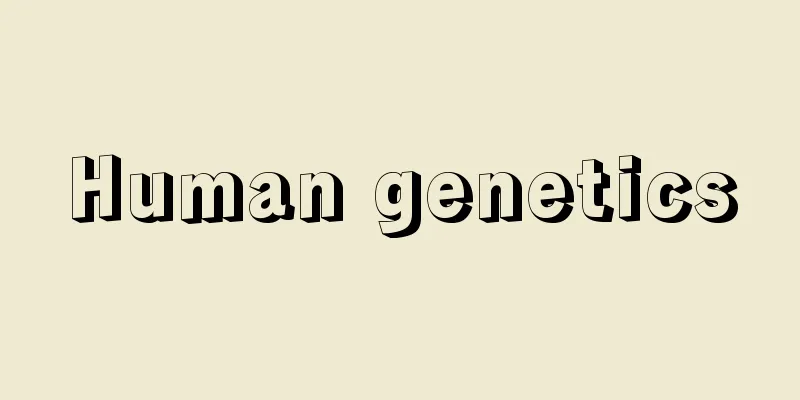Human genetics

|
A science that studies the origin, expression, inheritance patterns, and frequency and change in groups such as ethnic groups of various normal and abnormal human traits, such as physical and mental characteristics. Human traits include visible traits such as skin and hair color, face and body shape, limbs, and skeleton, as well as biochemical traits such as the physiological functions of internal organs, muscles, and nerves, and various enzymes and serum proteins related to the body's metabolism. There are also behavioral characteristics such as movement and exercise. A wide range of research is included on these various normal and abnormal traits, from studies of individuals or groups of humans, such as determining inheritance patterns such as dominant, recessive, and sex-linked based on family surveys, collecting data on groups and calculating gene frequencies through statistical analysis, to cytogenetic studies of changes in the structure and number of chromosomes that control the expression of the traits, and even molecular-level studies of enzymes, proteins, and nucleic acids. The study of human genetics reveals the biological qualities of individuals, families, ethnic groups, and the human race, and makes it possible to predict the physical and mental characteristics, strengths, and weaknesses of individuals or ethnic groups before they even appear. In particular, knowledge of human genetics is often useful in preventing various genetic diseases, such as avoiding incestuous marriages and selecting a spouse. In addition, chromosomal abnormalities, certain congenital metabolic disorders, and morphological abnormalities such as anencephaly and spina bifida can now be diagnosed before birth by testing the amniotic fluid of the fetus in the early stages of pregnancy. Furthermore, the number of genetic diseases that can be diagnosed early and whose symptoms can be prevented or alleviated by drugs, biochemical therapy, or surgery is gradually increasing. Examples include galactosemia, which can be treated with appropriate dietary therapy, phenylketonuria, type 1 diabetes (diabetes caused by destruction of the cells of the pancreas that produce insulin; four related genes have been identified), homocystinuria (a deficiency of the enzyme cystathionine synthesis, resulting in the excretion of large amounts of homocystine in the urine), histidinemia, an amino acid metabolism disorder (a genetic abnormality of the enzyme histidase, resulting in increased levels of histidine and its metabolites in the blood and urine), and tyrosinemia (an autosomal recessive genetic disease in which the amount of tyrosine in the blood increases due to a deficiency of the enzyme tyrosine decomposition, causing keratosis of the hands and feet and corneal contusion). Conditions that can be treated with surgery include hip dislocation, cleft lip and palate, polydactyly, congenital heart defects, and congenital pyloric stenosis. There are 23 pairs of 46 chromosomes in the human cell nucleus, of which 22 pairs of 44 autosomes are numbered from 1 to 22 in order of length. In addition, there are two sex chromosomes, XX in females and XY in males. Human genetic DNA is located at a specific position on these chromosomes, and in 2002, the complete base sequence, which is the genetic code unit for amino acid translation of this DNA molecule, was determined. Each genetic DNA consists of 3 billion pairs of the four bases adenine (A), guanine (G), thymine (T), and cytosine (C), and of these, only 2-3% act as genes, and the number is estimated to be between 30,000 and 100,000. Of these, approximately 8,000 genes on the autosomes and approximately 500 genes on the X chromosome have been identified. Research into each genetic disease has progressed at the genetic level, and many genetic DNAs have been cloned (specific genetic DNA is incorporated into the DNA of a virus or plasmid, which is then introduced into cells such as E. coli to produce large numbers of clones), and their base sequences have been determined. Advances in the analysis of these genetic diseases at the molecular and cellular levels are likely to lead to advances in prevention and treatment methods. Eugenics is the application of the findings of human genetics to improve the genetic qualities of human society and prevent their weakening. In particular, since around the 1970s, various mutagens have been detected in the human living environment, raising concerns about the effects of these substances on the genetic qualities of human beings as well as on cancer, and it has become necessary to thoroughly consider countermeasures. [Kuroda Yukiaki] "Human Genetics" by Takashi Komai (1966, Baifukan)" ▽ "Statistics in Science: The Intersection of Modern Science and Statistical Mathematics" edited by Hiroji Akaike (1987, Kodansha)" ▽ "Human Genetics, Vol. 1-2 by F. Vogel and A.G. Motulski, translated by Tokuichi Yasuda (1988, 1989, Asakura Shoten)" ▽ "Modern Genetics" by P.J. Russell, supervised translation by Jiro Ota, translated by Saeko Imaizumi and Kumiko Shimizu (1990, Ohmsha)" ▽ "Responding to Hereditary Diseases: Knowledge and Practice" revised and expanded edition (edited by Koji Okura, 1991, Kodansha)" ▽ "Human DNA Polymorphism: Detection Technology and Applications" edited by Katsuji Harada (1991, Toyo Shoten)" ▽ "In the Name of Eugenics: One Hundred Years of the Nightmare of 'Human Improvement'" by Daniel J. Kevles, translated by Nishimata Sohei (1993, Asahi Shimbun)" ▽ "Genetics for Humans" by Yasuda Tokuichi (1994, Shokabo)" ▽ "Civilization and Genetics" edited by Fukuda Ichiro and Liu Gang (1997, Benseisha)" ▽ "Issues in Medical Ethics" by Jan P. Beckman, supervised by Tobita Shuichi (2002, Fuji Shoten)" ▽ "An Invitation to Medical Genetics, revised 3rd edition by Shinkawa Norio and Abe Kyoko (2003, Nanzando)" [References] | | | | | | |galactosemia| | | | | | | | | | | | | | | | | | | | | | | | | |Source: Shogakukan Encyclopedia Nipponica About Encyclopedia Nipponica Information | Legend |
|
ヒトの身体の特徴や精神など種々の正常および異常形質の起源、発現、遺伝様式、あるいは民族など集団中における頻度や変化などを研究する学問。ヒトの形質には、皮膚や毛髪の色、顔や体の形、手足や骨格など目に見える形質のほか、内臓諸器官や筋肉・神経の生理的機能、体の代謝に関係する各種酵素や血清タンパクなど生化学的な形質がある。また、動作や運動など行動面での特徴もある。このような種々の正常および異常の形質について、家系調査に基づく優性、劣性および伴性などの遺伝様式の判定、集団を対象とした資料の収集とその統計的分析による遺伝子頻度の算定など、ヒトの個人または集団についての研究から、その形質発現を支配する染色体の構造や数の変化などの細胞遺伝学的な研究、さらには酵素やタンパク質、核酸などの分子レベルでの研究など、広い範囲の研究が含まれる。 人類遺伝学の研究によって、個人、家族、民族および人類の生物学的素質が明らかにされ、個人または民族の心身両面にわたる特徴、長所、短所などを、それらがまだ現れない前に予知することができるようになる。ことに各種遺伝病の予防として、近親結婚を避けたり、配偶者の選択などに人類遺伝学の知識が役だつことは多い。また、染色体異常やある種の先天性代謝異常症、無脳症、脊椎(せきつい)破裂などの形態異常は、妊娠初期の胎児の羊水を検査して、出生前に診断できるようになっている。 さらにまた、早期に診断がついた遺伝病は、薬物または生化学的療法や外科的手術によって、発病を予防したり、あるいはその症状を軽くすることのできるものがしだいに増えてきた。適当な食事療法によって治療できるガラクトース血症や、フェニルケトン尿症、1型糖尿病(インスリンをつくる膵臓(すいぞう)の細胞が壊れてしまった糖尿病で、関係する四つの遺伝子が同定されている)、ホモシスチン尿症(シスタチオニン合成酵素の欠損症で、尿中に多量のホモシスチンが排泄(はいせつ)される疾患)、アミノ酸代謝異常症のヒスチジン血症(ヒスチダーゼという酵素が遺伝的に異常になり、血中や尿中にヒスチジンやその代謝物が増大する疾患)、チロシン血症(常染色体性劣性遺伝病で、チロシン分解酵素の欠損により血中のチロシン量が増大し、手足の角化症や角膜潰傷をおこす疾患)などがその例である。外科的手術で治療できるものとしては、股関節脱臼(こかんせつだっきゅう)や口唇裂(こうしんれつ)、口蓋裂(こうがいれつ)、多指症、先天性心臓奇形、先天性幽門狭窄(きょうさく)症などがある。 ヒトの細胞核のなかには、23対、46本の染色体があり、そのうち22対、44本の常染色体は長さの順に1番から22番までの番号がつけられている。このほか女性にはXX、男性にはXYの2本ずつの性染色体がある。ヒトの遺伝子DNAは、それぞれこれらの染色体上の所定の位置に座位していて、2002年このDNA分子のアミノ酸翻訳の際の遺伝暗号単位である全塩基配列が決定された。この各遺伝子DNAは、アデニン(A)、グアニン(G)、チミン(T)、シトシン(C)の4種の塩基、30億対からなるが、そのなかで遺伝子として作用するのは、2~3%とされ、その数も3~10万個と推定されている。このなかで、常染色体上の遺伝子が約8000個、X染色体上の遺伝子が約500個同定されている。各遺伝病については、遺伝子レベルの研究が進み、遺伝子DNAがクローニング(特定の遺伝子DNAをウイルスやプラスミドのDNAに組み込ませ、それを大腸菌などの細胞に取り込ませて大量にクローンをつくりだすこと)され、その塩基配列の決定されたものも多い。これらの遺伝病についての分子レベル、細胞レベルでの解析が進むことで、その予防法や治療法も進歩するものと思われる。 人類遺伝学の成果を人類社会の遺伝的資質の向上や、弱体化防止に応用しようとするのが優生学eugenicsである。とくに1970年ごろより、ヒトの生活環境のなかに種々の変異原物質が検出されるようになり、これらの物質による発癌(はつがん)への影響とともに、人類の遺伝的資質への影響が心配され、その対策についても十分な検討が必要になってきた。 [黒田行昭] 『駒井卓著『人類の遺伝学』(1966・培風館)』▽『赤池弘次編『科学の中の統計学――現代科学と統計数理の接点』(1987・講談社)』▽『F・フォーゲル、A・G・モトルスキー著、安田徳一訳『人類遺伝学』1~2(1988、1989・朝倉書店)』▽『P・J・ラッセル著、太田次郎監訳、今泉佐枝子・清水久美子訳『現代遺伝学』(1990・オーム社)』▽『大倉興司編『遺伝性疾患への対応――その知識と実際』改訂増補版(1991・講談社)』▽『原田勝二編『ヒトDNA Polymorphism――検出技術と応用』(1991・東洋書店)』▽『ダニエル・J・ケヴルズ著、西俣総平訳『優生学の名のもとに――「人類改良」の悪夢の百年』(1993・朝日新聞社)』▽『安田徳一著『人のための遺伝学』(1994・裳華房)』▽『福田一郎・劉剛編著『文明と遺伝』(1997・勉誠社)』▽『ヤン・P・ベックマン著、飛田就一監修『医の倫理課題』(2002・富士書店)』▽『新川詔夫・阿部京子著『遺伝医学への招待』改訂第3版(2003・南江堂)』 [参照項目] | | | | | | | | | | | | | | | | | | | | | | | | | | | | | | | | | | |出典 小学館 日本大百科全書(ニッポニカ)日本大百科全書(ニッポニカ)について 情報 | 凡例 |
<<: Family register - Shinruigaki
>>: Mankind - jinrui (English spelling) man
Recommend
Leaf trace
… When leaves grow laterally from a stem, the ste...
Alpha rays - alphathene
A nucleus particle beam of 4He emitted by the alp...
Miki [town] - Miki
A town in Kida County in central Kagawa Prefecture...
Exonerated - Menso
Under the Criminal Procedure Law, this is a judgm...
Commutative group - Kakangun (English spelling) commutative group
In a group, when its operations are commutative (f...
Oligomer enzyme
...Furthermore, depending on how these secondary ...
《Kiss Me Kate》
…Porter also wrote lyrics characterized by comple...
Myitkyina (English spelling)
The capital of Kachin State in northern Myanmar. L...
Cinus de Pistoia (English spelling)
…The difference between this school and the comme...
ZANU
...A referendum on a new constitution was held in...
Isopropyl alcohol
Chemical formula: (CH 3 ) 2 CHOH. Also known as is...
Ring-headed sword
…In recent years, bronze swords have been excavat...
Kasakake [town] - Kasakake
A former town in Nitta County, southeastern Gunma ...
Sashimono - joinery
A small flag with a pole attached to the body in ...
Xiao Yun-cong (English name)
[Born] Wanli 24 (1596) [Died] Kangxi 12 (1673) A C...









